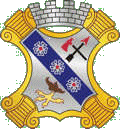(4TH INFANTRY DIVISION) IN THE HURTGEN FOREST,
GERMANY, 16-22 NOVEMBER 1944
(RHINELAND CAMPAIGN)
By Lieutenant Colonel James W. Haley

THE BATTALION PLAN OF ATTACK - 17 NOVEMBER
The battalion plan of attack for 17 November was essentially the same as that for the previous day and for that reason the attack was doomed to failure before it began. E and F Companies were again to attack abreast in the area in which they had been slaughtered the day before. The only two changes were that the companies were supplied with bangalore torpedoes during the night and an effort was to be made to get the tanks up the slope of the ravine to support the attack, which was to jump off at 0900. The primary mission assigned to the tank platoon was to break paths through the anti-personnel mine field end the barbed wire through which the foot troops could move. The tanks were to move up a narrow trail which wound its way up to the rock quarry about half way up the slope on the right flank of the battalion zone. (See Map D) From the rock quarry to the top of the hill they were to try to move cross country. The platoon was to move from its assembly area in the vicinity of Bend in order to cross the line of departure at 0900 along with the assault companies. The 29th Field Artillery Battalion and the 81mm Mortar Platoon were to cover the enemy position with fire beginning at 0845 and continuing until lifted by call from the Commanders of E and F Companies. 40
THE BATTALION ATTACK - 17 NOVEMBER
The morning of 17 November dawned cold and wet. A heavy mist hung over the front and the trees were dripping wet. By 0800 the tanks were working their way up the small trail leading to the rock quarry and the noise of their engines echoed through the woods, alerting the Germans. Immediately, the enemy artillery and mortar fire began to search the area surrounding the quarry. The men of E and F Companies crawled deep into their holes and waited for H-hour to arrive. By 0845 the tanks had reached the quarry and began looking for routes up the remainder of the hill.
At 0900, when E and F Companies climbed out of their wet and muddy holes, only one tank of the five in the platoon had reached the line of departure. All the others were mired or could not climb the steep slope.
As the attack jumped off, the enemy was pounding the area as on the day before. At 0930, the leading platoons had reached the farthest point of the previous day's advance after suffering heavy casualties and were again stopped. The one tank advancing with the attack moved through the anti-personnel mine field but could not break through the triple concertina wire. Several times it backed off and made paths through the mines bat it was never successful in breaking down the wire. The enemy continued to pour artillery and mortar fire into the assaulting troops and raked them with machine gun fire. To rise from the ground was almost sure death. In an effort to get a bangalore torpedo under the barbed wire, almost all of First Lieutenant Bernard F. Ray's platoon of F Company had become casualties. Realizing that something must be done at once, First Lieutenant Ray seized the bangalore and rushed forward. By some miracle he reached the wire and succeeded in placing the bangalore. In order to insure that the damp fuse would burn and that the gap would be blown, he decided to remain at the torpedo until it exploded, thereby sacrificing his life. For this display of heroism, he was awarded the Congressional Medal of Honor, posthumously.
Seeing First Lieutenant Ray's, display of courage, several other man, mostly non-commissioned officers, began to work their way forward to the wire. Only three or four escaped the enemy fire and were able to reach the barrier and place the bangalores. However, when the fuse igniters were pulled, the torpedoes failed to detonate. Later it was discovered that the fuses had been damaged by the exposure to the mud and water as they lay on the ground the previous night. 41
Even though a gap had now been blown in the wire as a result of First lieutenant Ray's heroism, the Battalion was unable to advance. At about 1000, the Battalion Commander ordered E and F Companies to withdraw to the positions from which they had jumped off and again the Battalion had suffered very severely without being able to reach the enemy position. The morale of the troops was shattered and it was very evident that the Battalion would have to be withdrawn from the line, reorganized and re-equipped before it would again be capable of effective action.
As E and F Companies ware falling back, the Battalion Commander called the Regimental Commander by telephone and informed him of the situation. He was told by the Regimental Commander to remain in the present position and make plans to continue the attack on 18 November. However, Lieutenant Colonel Jackson knew that the Battalion could not possibly accomplish this mission and so stated. It was then decided that the 3rd Battalion would attack on 18 November and the 2nd Battalion would withdraw to an assembly area in the vicinity of Bend to reorganize. This move was to be executed immediately after the 3rd Battalion jump-off. By daylight on 18 November, all casualties had been evacuated and all elements of the Battalion were prepared to withdraw to the same area from which they had departed on 16 November to cross the line of departure in the initial attack. 42

